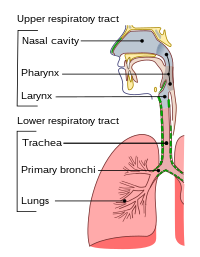
Photo from wikipedia
Abstract Background Rhinoviruses (RVs) are among the most frequently detected viruses from hospitalized children with severe acute respiratory infections, being classified into RV-A, RV-B, and RV-C (4 clades: C, GAC1,… Click to show full abstract
Abstract Background Rhinoviruses (RVs) are among the most frequently detected viruses from hospitalized children with severe acute respiratory infections, being classified into RV-A, RV-B, and RV-C (4 clades: C, GAC1, GAC2, and A2). This study aimed to compare the clinical characteristics and respiratory tract illness severity between the RV species and RV-C clades in children in primary care and hospital settings in rural communities in the Philippines. Methods Clinical samples and information of children <5 years old in the Philippines were collected from 2014 to 2016. The samples were tested by reverse-transcription polymerase chain reaction (RT-PCR) targeting the 5′-untranslated region. PCR-positive samples were sequenced, and RV species were identified by phylogenetic analysis. Results Overall, 3680 respiratory tract illness episodes in 1688 cohort children were documented; 713 of those were RV positive and identified as RV-A (n = 271), RV-B (n = 47), and RV-C (n = 395: C [n = 76], GAG1 [n = 172], GAG2 [n = 8], A2 [n = 138], and unidentified [n = 1]). Severe illnesses, low oxygen saturation, cough, and wheezing were more common in patients with RV-C, especially with GAC1, than in those with RV-A or RV-B. Furthermore, severe illness was significantly more common in RV-C (GAC1)–positive cases than in RV-A–positive cases (odds ratio, 2.61 [95% CI, 1.17–4.13]). Conclusions Children infected with RV-C had more severe illnesses than children infected with RV-A and RV-B. Moreover, emerging clades of RV-C were associated with increased severity.
Journal Title: Open Forum Infectious Diseases
Year Published: 2022
Link to full text (if available)
Share on Social Media: Sign Up to like & get
recommendations!